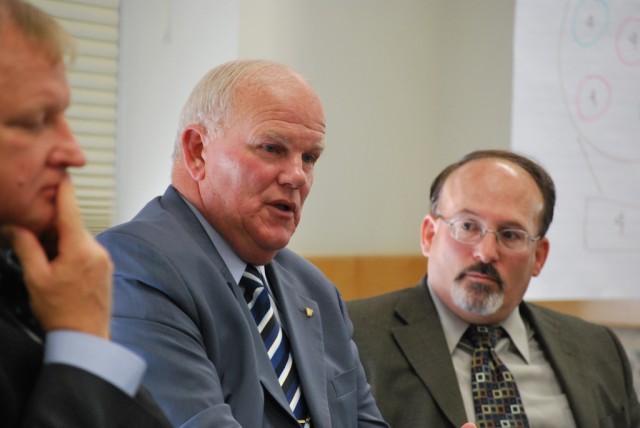
ABERDEEN, Md. -- Senior civilian leaders met with up-and-coming Aberdeen Proving Ground managers for a panel discussion on human capital, mentorship and transformation issues Aug. 25 at the Aberdeen Higher Education and Conference Center.
This is the second iteration of the APG Leadership Cohort Program. Twelve Army organizations from the installation selected 29 motivated managers to participate in a year-long professional development program designed to develop future civilian leaders.
"The Army is going to depend on all the leaders it has to look for ways to be more efficient in what they do every day," said Gary Martin, U.S. Army Research, Development and Engineering Command executive deputy to the command general. "When I look at where the opportunities are for leaders, it's in everything we do.
Martin led off the panel discussion by imploring the group to think strategically.
"We're going through a change at Aberdeen Proving Ground that is unprecedented," Martin said. "About the only time Aberdeen has seen this much activity was in 1917 when they created the post."
The APG Leadership Cohort Program began in 2009 as a way to grow senior leaders and build camaraderie across organizations, explained Beverly Obenchain, program coordinator. This group started in April, and they meet for two days each month.
"The program delivers real results that are significant and meaningful to the participants," she said.
"I think I'm getting a lot from the program," said James Lint, U.S. Army Communications-Electronics Life Cycle Command intelligence and security director. "Through the program I'm meeting other senior managers on the installation, learning about shared challenges and hopefully developing joint solutions."
Martin and two other Senior Executive Service civilian leaders, Douglas Bryce from the Joint Program Executive Office for Chemical and Biological Defense and Conrad Whyne from the Chemical Materials Agency, took questions from the group about BRAC, strategic planning and how to communicate change.
"I truly believe people are what makes things go; people are what makes us successful," Bryce said. "Leaders help in that. Leaders mentor people who make us successful."
Bryce said his organization is affected by the Base Realignment and Closure process as they prepare to move to the Edgewood Area of Aberdeen Proving Ground.
Martin said the BRAC continues to be a major challenge for all organizations on the installation.
"When you look inside of the organization and see where we are going as a community, we are still quite fragmented," he said. "These [leadership] programs and lunches are about the only thing we do to bridge organizational boundaries."
"Today's panel addressed many of the issues we face day-to-day," Lint said. "My organization is in the process of moving to Aberdeen Proving Ground from Fort Monmouth. For us, the BRAC is reality. It's important to remember what the panel members said about compassion for the workforce and understanding stress factors. Issues like the economy, family matters and BRAC inevitably influence how we go about performing our mission. As leaders we need to take this into consideration and constantly communicate with our workforce."
Martin said the fast pace of transformation will continue for some time.
"You owe it to your organization to get clarity from above on priorities and focus on the big things," Martin said.
Keeping a finger on the pulse of the organization is a key role of leadership, he said.
"You have to have compassion for your people," Martin said. "Leading people starts at the first point of engagement. As senior leaders we need to take a step back and ask what are we going to do day-to-day to facilitate the bigger picture' And that's really where leadership comes in."
"All of our employees are working at such a fast pace and have such a huge workload, which supports the war fighter in their own unique ways," Whyne said. "That means they can be so focused on their world, they can lose sight of the big picture or lose opportunities to interact with the greater community called Aberdeen Proving Ground with all of its tenant activities.
Whyne said the cohort program facilitates meeting peers, making contacts and friends, and learning about other organizations.
"It provides opportunities to exchange ideas, learn new and best business practices and support each other in the future," he said. "That provides a tremendous synergy to make their organization, Aberdeen Proving Ground and the Army more efficient and effective. That is why I believe the program is a win for all and must be supported by all."
"When this class is done, what will you take back to your organization'" Martin asked the group. "How can your organization be of greater value to the Army'"
These questions are what the leaders will take back to their respective organizations, he said.
"I highly recommend the Leadership Cohort Program to other leaders and managers," Lint said. "It's worth the investment of time and energy. They say you never stop learning. This is definitely a good opportunity to stay sharp, keep learning and contribute to the future."

Social Sharing